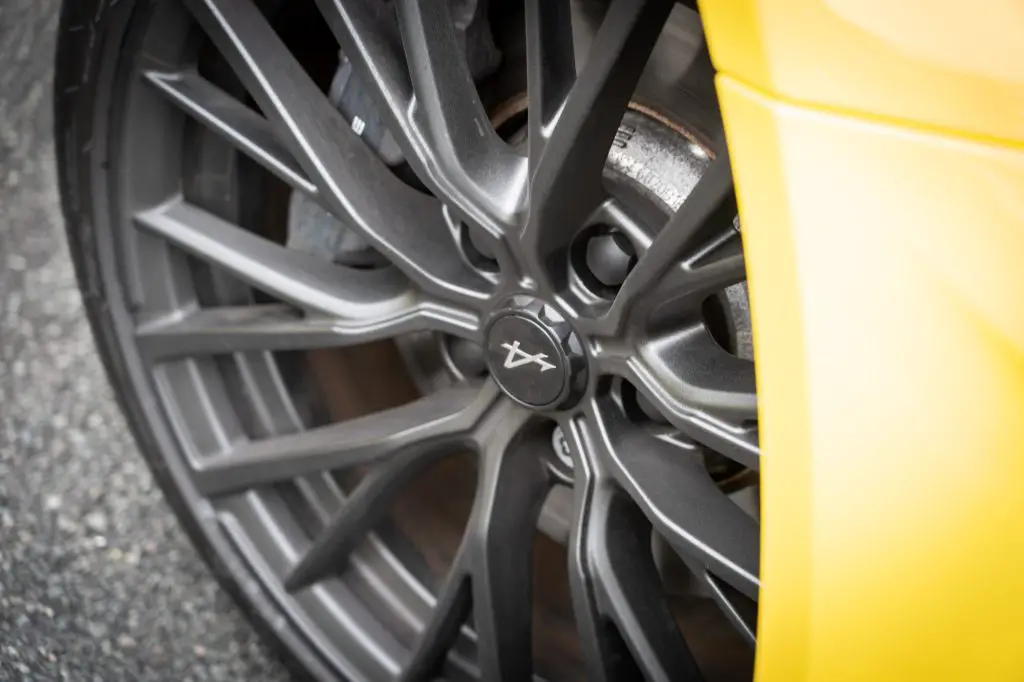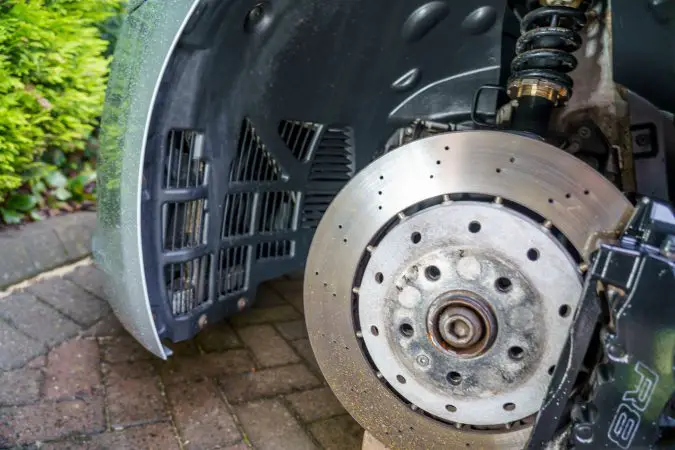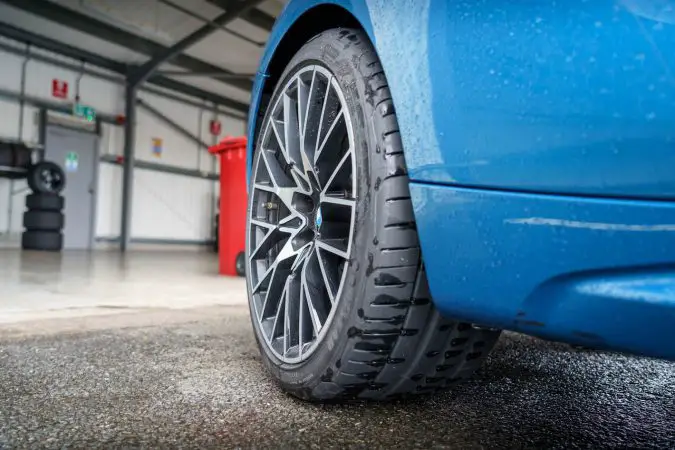So, have you been interested lately to learn more about car mechanics and the first question that came to your mind was, how many axles does a car have? That’s an interesting question because this topic is very broad and has a lot to discuss.
- What Is An Axle?
- Types
- Rear Axles
- Live vs Dead Axle
- How Many Axles?
- How Much To Replace
- Replace DIY
- Conclusion
The axles are basically pieces of steel that convert the rotary energy from the driveshaft into mechanical energy that moves your car on the road. They are basically steel rods that are used for the transfer of energy.
These axles are extremely tough because they are exposed to a lot of strain and need to be extremely well engineered in order to prevent the failure of this system. If an axle breaks, your car is probably stuck. And you will need someone to come and pick your car up and take it to the mechanic’s shop.
So, that’s why axles are crucial parts and need to be in check if you want your car to deliver some proper performance. But the question remains – how many axles does a car have?
Well, in this article we are going to answer that question of how many axles does a car have and more. We are going to learn what axles are, and how do they work in practice. This article will be a good mechanical tutorial for you to learn more about these axles. We also going to understand how much do they cost to replace. Plus, how you can replace them on your own. So, let’s begin.
What Is An Axle?
Axles are an integral component of every vehicle out there. Without axles, we wouldn’t have cars on the roads. The axles are the ones that move the vehicle forward or backward.
These axles have a special role to transmit the driving torque that comes from the driveshaft to the wheels. Also, they have another purpose, and that is to maintain the position of the wheels.
The axles are made out of very durable steel that is hard to bend. And basically, nothing can ruin this balance except a hard impact that will bend the axle.
There are non-driving axles or dead axles, which only act to separate the wheels and hold them in place and serve as a suspension component. And there are also driving axles that use the torque of the engine to move the vehicle.
These drive axles are connected to the transaxle or a differential. Most modern cars are using transaxles to connect the torque. This type of suspension is widely used in modern cars and is extremely popular. That’s because it delivers a lot of advantages when it comes to maneuvering the vehicle and keeping the car on the road.
Fixed axles are most commonly found and connected with a differential. They were adopted in large numbers with older cars, but in recent years there was a switch towards transaxle systems which almost retired this old type of automotive suspension system.
But there are still used a lot on trucks and other heavy machinery that requires a lot of strength to keep moving on the roads.
What Types Of Axles Are Out There?
There are basically three types of axles in road vehicles. A front axle, a rear axle, and a stub axle. And now we are going to cover all of them in-depth to see which is which and what is its role.
Front Axle
The front axle as its name implies is located at the front of the vehicle. The function of the front axle is to transmit the steering of the vehicle and transmit the power to the front wheels if the vehicle is front-wheel drive.
The one that transmits the power from the engine is called a live front axle while the one that is only transmitting the wheel input is called a dead front axle. The dead front axle stays in place and doesn’t rotate. Meanwhile, the live front axle is rotating and delivering power to the wheels.
These front axles are created out of durable materials. These include carbon nickel and carbon steel. This makes them extremely sturdy and robust against any impact. The front axle consists out of four parts and these parts include the beam, track rod, stub axle, and a swivel pin.
Stub Axle
The stub axles are attached to the front wheels of the vehicle, and then by the use of kingpins, these stub axles are connected to the front axle.
There are four types of front stub axles and include Eliot, Reverse Eliot, Lamoine, and Reverse Lamoine.
Stub axles are not that important in our article because we are mostly focused on the front and rear axles. These two are the important bits that participate in converting the torque power into mechanical speed.
Rear Axle
The rear axle, as the name implies, is located in the rear of the car. More precisely, between the two back wheels. The rear axle is separated in the middle by the differential. The differential gets turning momentum from the driveshaft and is spinning the axles that are located on each side of the vehicle.
In most cases, one of the rear axles is live and the other starts spinning when there is a need to. Or if you have a limited-slip differential. It’s going to rotate both rear axles at a different speed in order to deliver the right amount of power.
There is also a fixed rear differential that delivers the same output to both of the wheels. This is cool if you want to do burnouts with your car. In most cars there is a limited-slip differential that only spins one of the tires. How you can get a fixed differential is by welding the diff so that both of the rear wheels will spin at the same time.
This can also be dangerous, especially if you accelerate from zero to 60 at high speed. If you are not experienced this fixed diff can easily make you lose the grip and end up in a ditch. But now let’s see what types of rear axles are out there.
Types Of Rear Axles
How many axles does a car have? There are also some subtypes of rear axles and we are going to cover all of them in detail.
Semi Floating Axle
The semi-floating axle works in a way that connects the wheel to the wheel flange bearing which is located on the axle exterior shaft and holds it securely. This type of axle has two bearings. One of these bearings is supporting the axle shaft. Meanwhile, the other bearing is going inside of the axle casing.
Because the semi-floating axle has two bearings, it requires a larger size to produce the same amount of torque. These semi-floating axles are usually mounted on big SUVs, pick-ups, cars, and some midsize trucks.
Full Floating Axle
The full floating axle, as its name implies, is working in a way that is efficiently floating in place and maintaining its position in the process. All of this is thanks to the two bearings that this floating axle has.
This floating axle is transmitting the driving torque and this type of axle works best for some heavy-duty vehicles like big semi-trucks, midsize pickup trucks. Basically, vehicles that have a large towing capacity and a four-wheel drive.
These axles are designed in that way to survive some harsh conditions to which these vehicles are exposed. They are known for their durability and the ability to carry extremely heavy loads.
These axles are also heavy, but far more durable than regular car axles as they are also surrounded by a hefty axle housing that is almost bulletproof. This axle housing is made to withstand many tons of pressure and always delivers a good performance.
So, to sum up really quick. Semi axles are mainly used in SUVs, even though full-floating axles were also used in cars till recently. But most of the SUVs on the road are driven on semi-floating axles.
Semi floating axles are used on SUVs mainly because they deliver better performance and driving capability than the full floating axle. And also, we have to look at their relative inexpensiveness compared to a full floating axle.
Semi floating axles and full-floating axles require a differential housing for the differential. That’s unlike a CV axle that is connected directly to the differential. However, there are also three-quarter floating axles. So, let’s find out something more about them.
Three Quarter Floating Axle
Three-quarter floating axle as the name implies, only three-quarters of its mass is floating. They are far more complex and more reliable than semi-floating axles. These axles also aid to maintain the wheel alignment and improve handling.
Live Axles VS Dead Axles
These axles are further classified into two other subtypes and these are drive axles and dead axles. The drive axles as the name implies, they are delivering the torque power which is created by the engine.
They transmit power and move the wheels. This is where there is a differential that is bringing all this torque to the wheels. The differential is an essential part that delivers the right amount of torque to each wheel.
The dead axle on the other hand is also called a lazy axle. This axle is a free rotating axle that isn’t connected to the engine or any other drivetrain component. Thus, delivering no power. This dead axle is only serving one purpose and that is to keep the wheels properly aligned between each other and doesn’t allow them to crumble. These dead axles are widely used as front axles of two-wheel drive pickup trucks, or on semi-trailers.
In cars, if the car is a front-wheel drive, the rear axle is a dead axle. So how many axles does a car have? Well, we are going to answer that question in the next chapter.
How Many Axles Does A Car Have?
We finally reached the question that is bothering all of us. And the answer is simple. The car has two axles. And if you are driving a rear-wheel-drive car, they are both located in the back.
As we said they are separated by the differential which is feeding them with torque to spin them. In front-engine vehicles, there are also two axles, and both of these axles are connected to the transfer case.
At the back, there is no rear dead axle or lazy axle as we call it because there is no need to. Most modern cars have independent suspension which does not require axles to be installed to keep the car moving on the road. This makes the suspension much simpler to repair, and cheaper to maintain.
Moreover, the independent suspension allows better handling, so the wheels can move better and do not interfere with one another. This is most pronounced while cornering. Through tight corners, a car with independent rear suspension would handle much better compared to a car with a fixed full floating axle. It’s no surprise that these types of axles are only installed on trucks these days.
In the past, they were mainstream and were included on every possible vehicle on the road. But as time has advanced, we learned from our mistakes and so we improved the cars in order to deliver a better performance. And now since we answered the question how many axles does a car have. It’s time to move to some other topics.
Sings Of A Broken Axle
An axle can break if it’s subdued to a big amount of load. If the load on it is too heavy it’s going to snap immediately. This is very frequent when people overload their trucks above the factory limits. They think it’s all good and when they apply the throttle on an uphill the axle just snaps in pieces.
So, the best thing is to never overload your truck and always try to follow the factory-recommended specs. It doesn’t mean that if once you achieved to do this that you are going to be able to do it again. You never know when the axle can snap in pieces.
Another example of when these axles break is from a lot of torque. Let’s say your rear end is rated for around 200lb-ft of torque, and you decide to install a big V8 engine with 600 horsepower. Your rear end will shatter into pieces after you apply the throttle. When doing these types of upgrades pay attention to these things.
When you add horsepower, it means that you also need to upgrade all the other components to handle this power the right way. If not, your components will suffer and break apart.
And the last example is from cars that were in an accident. This is most pronounced when there is a collision on the frontal or the rear suspension. Going through bumps at high speed will be deadly for your suspension components as well as for the axle. Hitting a pothole at high speed can shatter your axle and your car will be undrivable. You won’t be able to move it from the place and you will lose a lot of nerves and time to load it on a truck.
How Much Does It Cost To Replace An Axle?
Rear axles are fairly inexpensive, they are basically iron rods that connect to your rear differential. They can be found for cheap prices like $150 depending on the make and model of your truck or car.
But in some more modern cars which incorporate axle CV shafts, these components can be pricier. These CV shafts are most widely used on front-drive cars. These types of shafts are more unique and more advanced compared to the old-fashioned axles that are installed in the differential housing.
These CV shafts come with bearings and all that jazz. This makes them more expensive and they can cost more than $300 for a new piece. So, if you blew your front suspension and you need to replace these components it can be pricey. But still, you can find these components on the second-hand market for really cheap. Although, you never know what you get with the sellers today. They can send you some bent one that will ruin your day when you see it.
So, when you are adding new parts to your suspension. The best thing is to go for new hardware. It may come at a higher price. But in the end, it will be a lot cheaper since the parts are going to last for a very long time and you will never have to worry about replacing them ever again.
How To Replace An Axle DIY?
Now let’s learn how you can replace an axle in a DIY fashion. This is important to know if you get a bad axle problem one day to know how you can get this thing sorted out. In our small tutorial, we are going to explain how to replace a front axle. Remember that this is not a regular truck axle but a modern CV axle shaft.
Step 1
This step involves removing the tires for you to have the access to start the work on the axle.
Step 2
Now it’s time to remove the axle nut cotter pin. Once removed the cotter pin. Now you have to remove the axle nut.
Step 3
Remove the axle nut and then disconnect the ball joint that is located behind the brake caliper. This ball joint also has a cotter pin which needs to be removed.
Step 4
Once removed the cotter pin, disconnect the ball joint from its place and remove the whole rotor assembly out of your way. This is of big importance if you want to access the axle.
Step 5
After you have removed the rotor now it’s time to remove the CV axle. There are two intermediate-bearing bolts that need to be removed for you to access the axle. Make sure that you remove them completely.
Step 6
Now it’s time to remove the axle, you just need to pull the axle from its place replace it with a factory OEM part. Make sure that the part is correct for your vehicle if not this will not going to work.
Step 7
After you placed the new axle in place then it’s time to bolt down the intermediate bearing bolts to keep it in place. When you are done with this step then it’s reassembly time. You need to bring everything back in place and go for a test drive.
Pro Tip
When doing this type of work it’s also useful to get your wheels aligned and make sure that they are perfectly aligned. Take your car to an alignment shop to perform this job.
Can I Drive With A Broken Axle?
You can’t drive a car with a broken axle because it will not drive straight if it’s bent or the bearings are gone. It’s going to pull on one side and will possibly take you into an accident. So, don’t do that if you want to stay safe.
Facts about Car Axles: Types, Function, and Maintenance
- An axle is a rod or shaft that rotates the wheels and supports the weight of a vehicle.
- Every vehicle has axles as they control the power that propels the wheels.
- Cars typically have two axles to rotate the wheels, while larger vehicles may have more axles.
- Customized axles can adjust the wheels’ speed and torque to a finer degree than pre-designed axles.
- Axles come in three standard types: rear, front, and stub.
- Rear axles deliver power to the driving wheels, while front axles assist with steering and process shocks.
- Stub axles are attached to the front wheels, with kingpins connecting them to the front axle.
- The three types of rear axles are semi-floating, full-floating, and three-quarter floating.
- Vehicles have two main types of front axle: dead front axles and live front axles.
- Signs of axle disrepair include a loud clunk when putting the car into gear, vibrations while driving, and the vehicle not moving forward or backward. Choosing the right axle ratio is important when planning to tow heavy trailers or haul large loads.
How Many Axles Does A Car Have – Conclusion
In this article, we have covered a lot when it comes to axles. We answered the question of what is an axle and how these axles work. Then discussed the types of axels that are out there and then we answered the question of how many axels does a car has?
And as we concluded there are two axels on each side. These axels are connected to the differential in rear-wheel-drive cars and with a transfer case on a front-wheel-drive car.
Then we covered how much is it to replace an axle because money is important at the end of the day. And finally, we discussed how you can replace a CV axle by yourself at your garage. Axles are not that complex after all.




